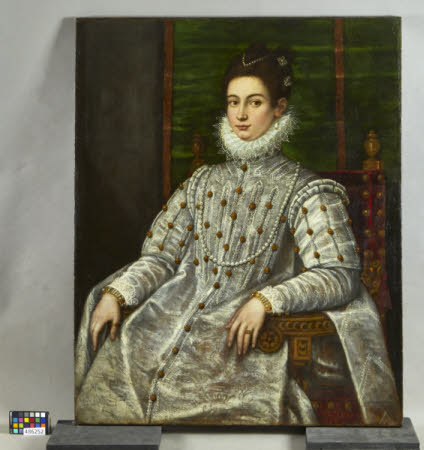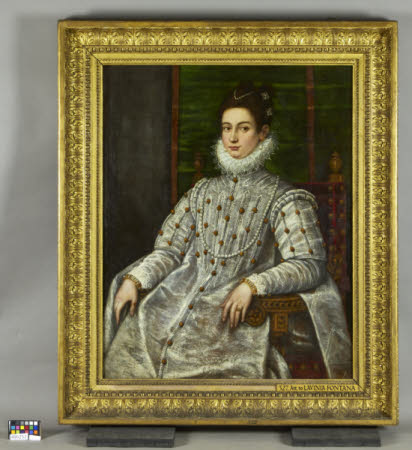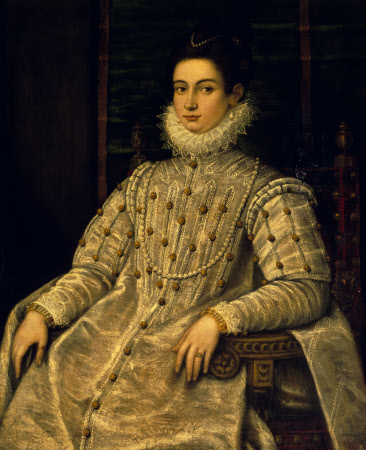An Unknown Noblewoman seated in a Chair
attributed to Lavinia Fontana (Bologna 1552 - Rome 1614)
Category
Art / Oil paintings
Date
1570 - 1629
Materials
Oil on canvas
Measurements
1055 x 840 mm
Place of origin
Italy
Order this imageCollection
Petworth House and Park, West Sussex
NT 486252
Caption
Lavinia Fontana is thought to be the first Western woman to have had a prosperous career as a traditional painter outside a court or convent. To have attained this distinction during a period of outstanding artistic achievement in Italy makes it all the more remarkable. As well as being the first Italian woman known to have had her own studio, she was also the mother of 11 children, of whom, tragically, only three would survive her. Initially trained by her artist father, Prospero, Lavinia’s education included Latin, music and an introduction to humanist scholarship, befitting Bologna’s reputation as a centre of female learning. In this stately portrait (opposite) a gentlewoman of Bologna is sumptuously dressed in a gown of pearly silk embellished with a pattern of gold studs and buttons. Swathed in pearl jewellery, she is seated in a red chair with a narrow silk hanging of green behind, reminiscent of a throne canopy. The colours of white, green and red may be an allusion to the theological virtues of Faith, Hope and Charity. Pigment analysis has revealed that shell gold (paint containing powdered gold) has been used for decorative highlights to the painting, along with silver for the dress. Fontana’s remarkably detailed attention to the costume and jewellery of her sitters, particularly the rich fabrics of Bologna’s thriving silk industry, must have made her an attractive choice for the city’s numerous patrons. The sitter, although unidentified, may appear in another late work of Fontana’s, the ambitious and monumental painting The Visit of the Queen of Sheba to King Solomon (1599). Fontana’s work appears to have become more experimental following her father’s death in 1597 and her years of child-rearing. As with Sheba and Solomon, this portrait shows evidence of changes made by the artist during painting, for example to the back of the chair and the position of the sitter’s left hand.
Summary
Oil painting on canvas, An Unknown Noblewoman seated in a Chair, attributed to Lavinia Fontana (Bologna 1552 – Bologna 1614). A three-quarter-length portrait, seated, three-quarters left, in an arm-chair, dressed in silver-grey with gold buttons, a pearl necklace, ruff and gold pearl-studded bracelets. A green silk hanging is shown behind the figure. This figure shows a close affinity to the woman holding a clock, third from the left in the procession featured in Fontana's The Visit of the Queen of Sheba to King Solomon (National Gallery of Ireland, NGI.76) and could have been based on the same sitter.
Provenance
In the collection of the 3rd Earl of Egremont (1751-1837) by 1835. Thence by descent, until the death in 1952 of the 3rd Lord Leconfield, who had given Petworth to the National Trust in 1947, and whose nephew and heir, John Wyndham, 6th Lord Leconfield and 1st Lord Egremont (1920-72) arranged for the acceptance of the major portion of the collections at Petworth in lieu of death duties (the first ever such arrangement) in 1956 by H.M.Treasury.
Credit line
Petworth House, The Egremont Collection (acquired in lieu of tax by HM Treasury in 1956 and subsequently transferred to the National Trust)
Makers and roles
attributed to Lavinia Fontana (Bologna 1552 - Rome 1614), artist
Exhibition history
Lavinia Fontana: Trailblazer, Rule Breaker, National Gallery of Ireland, Dublin, 2023
References
Brady, Canavan and Marcattili 2021: Aoife Brady, Maria Canavan and Letizia Marcattili, The Crowning Glory: Lavinia Fontana’s Queen of Sheba and King Solomon, National Gallery of Ireland, 2021, pp. 21-22 Brady 2023: Aoife Brady, Lavinia Fontana: Trailblazer, Rule Breaker, exh.cat., National Gallery of Ireland, Dublin 2023, no. 60, p. 139. Conroy, Rachel, Women Artists and Designers at the National Trust, 2025, pp. 31031



